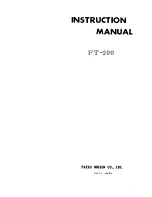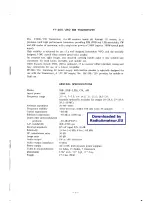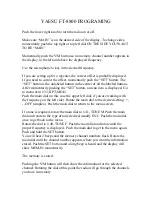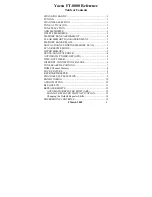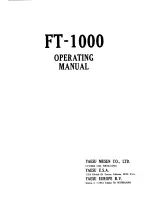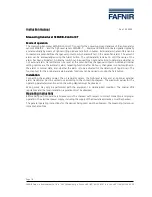
FX 146
•
50
G: PLL Frequency Synthesizer
H: Diode Matrix, Frequency Programming
M: Microphone Amplifier and PTT
TC: Transmit Coil and RF Choke Preparation
TX: Transmit Buffer, Driver and RF Final
PART
VALUE or ID
STEP
NOTE:
[ ] [ ] C1
.001
A16
[ ] [ ] C2
.001
A13
[ ] [ ] C3
.001
A14
[ ] [ ] C4
.001
A15
[ ] [ ] C5
.01
CR9
[ ] [ ] C6
.1
CR15
[ ] [ ] C7
4.7 or 10 uF
CR16
[ ] [ ] C8
.1
CR11
[ ] [ ] C9
4.7 or 10 uF
CR10
[ ] [ ] C10
.001
CR19
[ ] [ ] C11
.1
CR17
[ ] [ ] C12
47 pF
CR21
[ ] [ ] C13
.1
CR12
[ ] [ ] C14
27 pF
CR13
[ ] [ ] C15
120 pF
CR20
[ ] [ ] C16
.01 uF
CR8
[ ] [ ] C17
100 pF
DR28
[ ] [ ] C19
56 pF
TX38
[ ] [ ] C20
100 pF
DR16
[ ] [ ] C21
10 pF
F8
[ ] [ ] C22
100 pF
DR24
[ ] [ ] C23
.001
M5
FX-146
•
97
?
F18. Install C35, 100 pf disc capacitor (marked 100 or 101). C35 couples
the VCO buffer to the receiver IC.
?
F19. Install C94, a 3.9 pf disc capacitor (marked 3.9).
?
F20. Solder 1/4" lengths of bare wire (trimmed from resistors or
capacitors) in the two test point holes marked TP2 and TP3. Study the
following optional test procedure before installing a similar test point at
TP1.
F21: TEMPORARY RECEIVER PTT/T-R CONNECTION
OMIT this step if you prefer to install ALL transceiver parts before any testing
or use of the Receiver alone. If you wish to conduct further tests or put the
receiver to work, it is necessary to solder a 5" length of hookup wire from
the hole marked "+8R" (near Q13, R112) to the hole marked "+8V" near
C29. In lieu of the switching done by the PTT circuit (Stage M), this
temporary jumper a8V to all +8R points on the board. (You also
have, of course, the option of wiring the microphone input and PTT circuitry
before testing the receiver.)
Even if you do not perform the following test, be aware that there is one
more step following this discussion (F22) - please don't forget to do it.
OPTIONAL VCO RECEIVER TEST OR INSTRUCTIONAL
DEMONSTRATION
At this point in building your transceiver, the VCO is functional but is lacking
any control voltage to varactor diodes D3 and D23 that would permit tuning.
Supplying this precision controlled voltage is, of course, the function of the
PLL Frequency Synthesizer that will be constructed next. However, for those
who would benefit from such a test or demonstration, it IS fairly easy at this
point to set up temporary manual or "analog" tuning with an ordinary
potentiometer.
Notice on the schematic diagram that the control voltage to the tuning diodes
comes from U5A through R47 and R25. Notice that a Test Point (TP1) is
conveniently located at R25. The purpose of TP1 is to permit measurement
of the precision voltage to the varactor diodes generated by the frequency
synthesizer's phase detector. Since no such voltage is yet reaching TP1, we
can put it there ourselves! If we connect a potentiometer as illustrated below,
the wire soldered to TP1 can be trimmed down later to serve as the intended
test point. The potentiometer will vary the voltage to D3 and D23, thereby
varying the VCO frequency and tuning your receiver.































